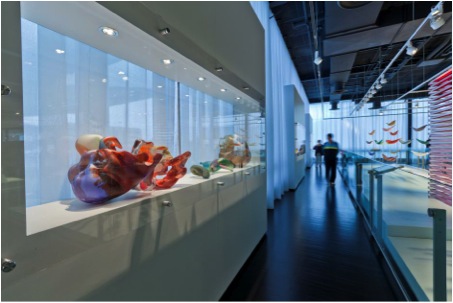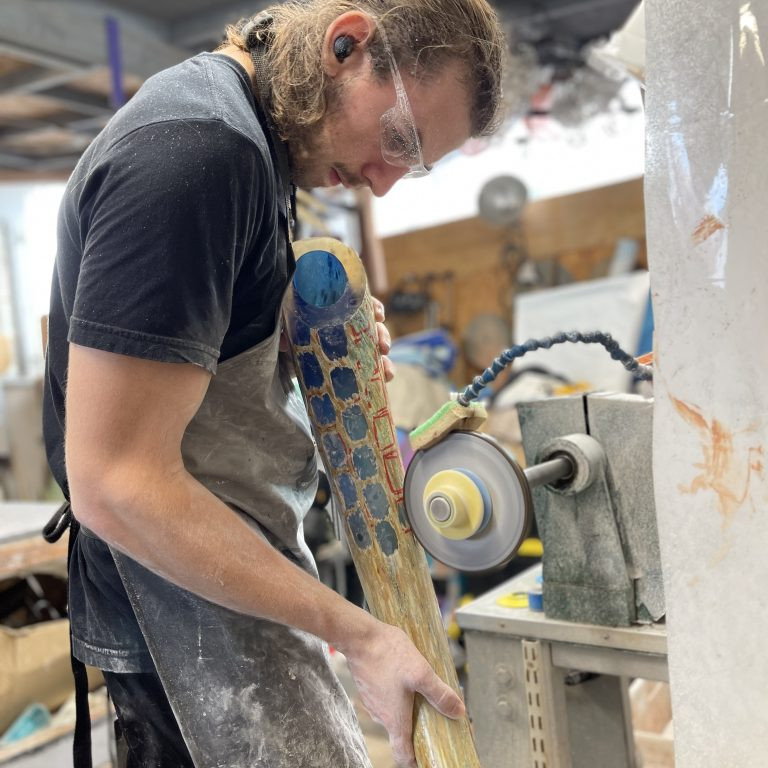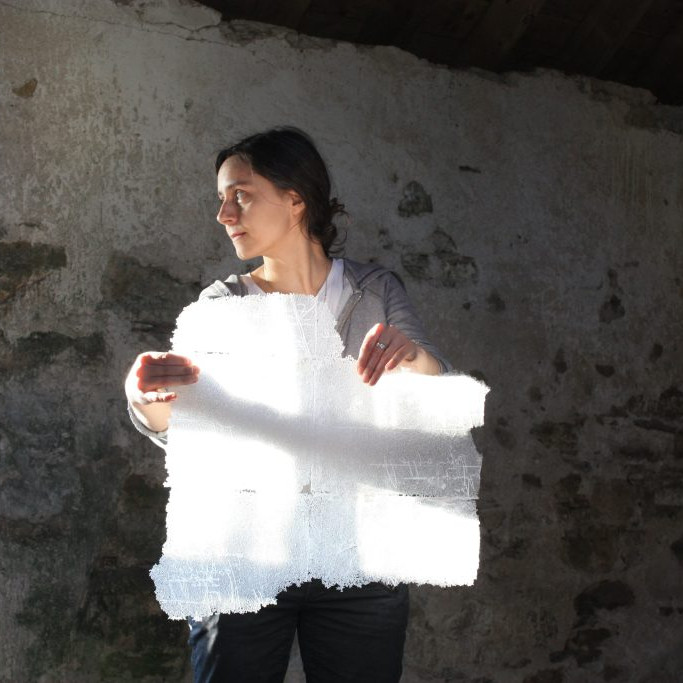Ben W. Heineman Sr. Family Gallery of Contemporary Glass At The Corning Museum Of Glass
Tell us about the location of Ben W. Heineman Sr. Family Gallery within the Corning Museum of Glass?
The Ben W. Heineman Sr. Family Gallery of Contemporary Glass is often the first gallery within the Museum that visitors encounter. The Corning Museum is home to the world’s most comprehensive collection of glass with nearly 50,000 objects, including the finest examples of glassmaking spanning 3,500 years. The glass collection galleries explore Near Eastern, Asian, European, and American glass and glassmaking from ancient Egyptian and Renaissance Venetian masterpieces to works by contemporary artists. The Heineman gallery is an introduction to contemporary glass with a focus on vessels, objects, sculptures, and installations made by international artists over the last 30 years. The purpose of the gallery is to show the different ways in which glass is used as a medium for contemporary art. Large-scale work is complemented by smaller-scale objects and non-functional vessels in a variety of glassworking techniques, including blowing, casting, kiln forming, flameworking, laminating, stained glass, beading, and assemblage. The gallery features unique objects, rather than limited-edition or mass-produced products.
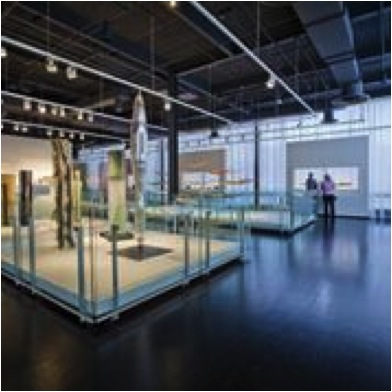
In 2005 the museum was given a major collection of contemporary glass by the Ben W. Heineman Sr. Family. How large is this collection?
Over the course of 30 years, American art collector and former Chairman and CEO of Northwest Industries, Ben W. Heineman Sr., and his wife, Natalie G. Heineman, thoughtfully assembled one of the largest and finest private collections of contemporary studio glass in the United States. The Heineman collection includes 240 objects, dating from 1969 to 2005, by 87 international artists including Howard Ben Tré, Dale Chihuly, Michael Glancy, Stanislav Libenský and Jaroslava Brychtová, Harvey Littleton, Richard Marquis, Klaus Moje, Joel Philip Myers, Tom Patti, Lino Tagliapietra, Bertil Vallien, and Toots Zynsky. The gallery was named in honour of the Ben W. Heineman Sr. Family gift, and it contains objects from the Heineman Collection as well as objects from the Museum’s collection not given by the Heinemans.
Is there funding attached to the donation for further purchases?
No, but when Mr. and Mrs. Heineman were alive, they often gave funds towards the purchase of contemporary glass that the Museum wished to buy.
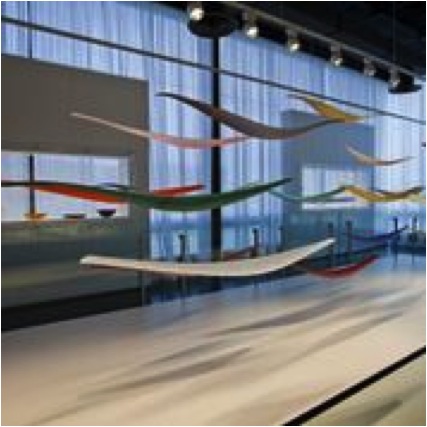
Does it fund any training of artists or other scholarships?
No, but the Museum is fortunate to have other donors who are committed to funding scholarships to the Museum’s Studio, which offers year-round instruction in all kinds of glassworking.
Is the family still involved with the Gallery?
The family is very interested in the Museum’s programs and activities, but like Mr. and Mrs. Heineman, they do not get involved. The reason they gave their collection to Corning was because they admired the Museum and its programs, and they expect the staff to do the best job they can.
How often is the gallery space changed?
Recently, every three or four years, we have changed the gallery entirely, which is a months-long undertaking. New objects are constantly added to the gallery, or certain cases may be changed, which is easier to do than change the entire gallery. For example, we have a series of six wall cases that were recently changed to feature examples of contemporary design.
Lighting is very important in all galleries but particularly to the display of glass can you comment on this?
Glass will take all of the light you can give it, so there is no such thing as too much light for contemporary glass, but guard against the heat that light creates. Often, when I see glass displayed, it is under-lit and it does not look as good as it could.
Wherever you display glass, what you want is a relatively constant temperature and humidity, with no extreme fluctuations from hot to cold. People like to display glass in windows on top of a radiator: this is a bad idea because the glass can crack or break. Glass in a window is fine, as long as it does not get too hot. Glass is very stable but two things can easily cause it to break: dropping the glass object on a hard surface (we all know that) and moving glass from a very warm environment to a cold one. This can cause thermal shock and breakage unless you have glass that is specifically tailored for these kinds of changes, such as glass ovenware.
Can you discuss three pieces from the collection?
Three of our visitors’ favourite pieces in the contemporary collection are:
Fern Green Tower (1999, reconfigured in 2013) by the American artist Dale Chihuly
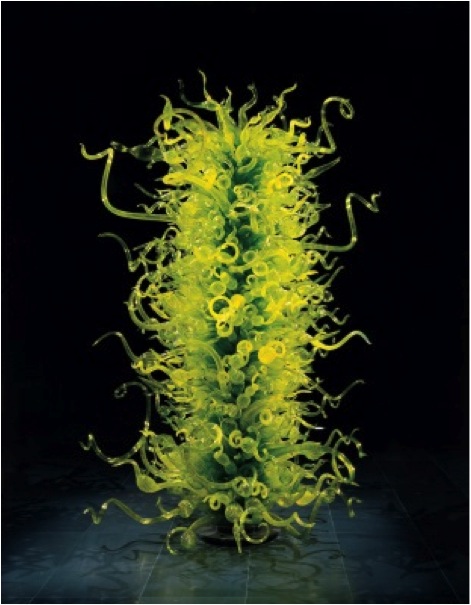
Fern Green Tower is 4.5 meters high (15 feet)
Evening Dress with Shawl (2004) by the American artist Karen La Monte

Evening Dress with Shawl is life-size
Red Pyramid (1993) by the Czech artists Stanislav Libenský and Jaroslava Brychtová.
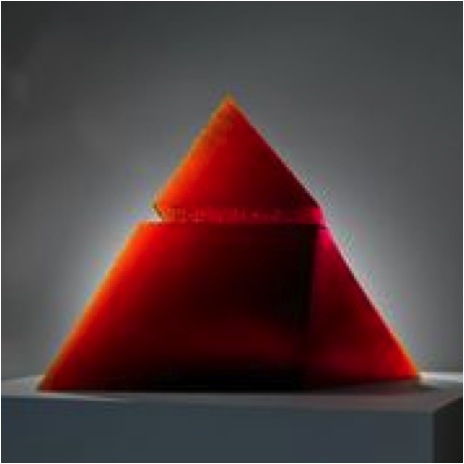
Red Pyramid is 1.2 meters wide (4 feet).
These are large sculptures. Fern Green Tower is 4.5 meters high (15 feet); Evening Dress with Shawl is life-size; and Red Pyramid is 1.2 meters wide (4 feet).
Tina Oldknow, as your gallery is within a museum, how do you see your role as a curator?
The entire museum is devoted to glass, and contemporary glass is only part of that story, and only one (albeit the largest) of many galleries. (Of course, we do not sell artwork from any of the Museum’s galleries, which may seem obvious, but it is surprising how many people think that museum objects are for sale). I work with the director and the other curators, who work with the Museum’s collections of ancient and Islamic glass, European glass, and historical American glass. Although much contemporary glass intentionally breaks with the past, many objects are inspired by history. My gallery is not separate from the rest of the Museum, but closely connected to it.
You have formal training in Art History; what lead you to specialize in Glass?
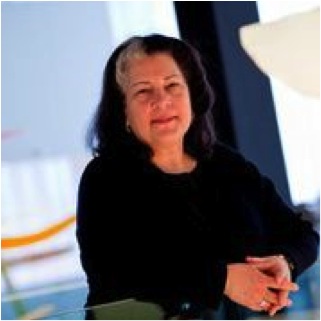
I became interested in glass when I was studying ancient art, but there has been no formal training in glass or other decorative arts offered in the States until recently, and even now there are only a handful of programs that specialize in it. Most art history programs do not include decorative arts or design. However, it is important for anyone involved in the arts to understand the larger chronology of the history of art, and that means painting and sculpture. For my job, knowledge of contemporary art and design is essential, from painting and sculpture to video and installations to functional objects because glass is now used in so many ways.
For a new collector of glass what would you suggest as an excellent foundation book and/or website?
Of course, the Corning Museum of Glass website is excellent and we all work hard to make it that way. There are many books about contemporary glass, including those offered by the Museum, and you can easily search for books online. They usually have “contemporary” or “studio” and “glass” in the title.
How important do you think it is to have specific galleries / museums (e.g. Glass)?
I think it makes sense for the city of Corning to have a museum devoted to the material that its historic, Fortune-500 company, Corning Incorporated, has made famous. I think that niche museums provide a wonderful opportunity to go deep into a subject, whether they are focused on geography (such as American or Australian art or contemporary art or folk art) or a material (glass, ceramics, textiles). I enjoy the big encyclopaedic art museums, and I enjoy the smaller, focused ones. We need all kinds of museums, and the more variety, the better.

How is collecting different for an institution and a personal collector?
There is a huge difference! Collectors buy what they want, although the best collectors I know are very focused and do not buy just anything. Like curators, they need to be very knowledgeable about their subject. Although my taste and judgement will always influence me, I am also aware of the public. I need to balance the objects I believe are important in our own time with what we know that the public enjoys. This is not very challenging. I have found the public is very responsive to all kinds of contemporary art in glass, and that people are more open-minded and intelligent than they are credited as being. About half of our Museum’s visitors have never been to a museum before. Glass is a great place to start to learn about contemporary art, because it is accessible: there are thought-provoking ideas but it also can be just very beautiful.
Can you very briefly discuss the importance of a good eye to the $ value of a piece?
To be a good curator, you have to love objects more than anything else. Some people like to research and the objects are secondary for them, whether it is the history or the ideas that they are interested in. You need both though: you need a great object and a great idea. Monetary value fluctuates and is subject to economic pressures that have little to do with the making of art. The Museum has bought amazing objects for very little money and amazing objects for a lot of money. In any display case, you might find an object valued at several hundred dollars nearby something valued at many thousands. Although curators are expected to know the market value of their objects, they do not collect for investment but for cultural and historical importance. There are always speculators, but most serious collectors do not collect solely for investment. They grow to love the work because they spend a lot of time learning about what they are collecting. In terms of investment, the wisest advice I have heard is to know about what you want to collect (that is, read, read, read) and collect the art you love.
How important are new techniques to contemporary glass making?
New techniques and ideas – all kinds of innovation – are always important. However, there are many ground-breaking artworks made with very traditional (that is historical) glassworking techniques.
When you do exhibitions do you bring artists together with a theme or do you only exhibit work the Museum owns?
The Museum does both. We have exhibitions that feature works drawn from the permanent collection, which is a wonderful way to bring artworks out of storage, and we create loan exhibitions that bring together objects that may have not been seen together before, and possibly may never be seen together again. The Museum’s permanent collection galleries are organized chronologically, and its loan exhibitions are always thematic.
Since you began at Corning Museum of Glass, can you give two highlights that have happened?
The Museum’s permanent collection galleries were renovated in 2000, which means that all of the glass in the Museum was taken out and put back in a different configuration with new exhibitry. This was a big project and very exciting. Not all curators get to do a project like that. Now, we are working on new galleries for contemporary glass, which will open in late 2014. This is also very exciting: the new galleries will display contemporary glass in addition to the existing Heineman Gallery, which will be completely changed. I feel very fortunate to have been able to work on these major projects.
Has the Corning Museum of Glass brought a glass arts community to the area?
It has, and one reason is because the Museum hires quite a number of artists. That is the best way to bring artists into an area: give them jobs. Many artists cannot make a living from their work alone, or they work to make money to set up their studios. It also helps that Corning has very reasonable real estate prices.
How important are relationships between artists and the curator of a Gallery such as yours?
Very important, I could not do my job without cultivating relationships with artists. They are tremendously supportive of the Museum.
In your opinion what makes a gallery a place visitors what to return to?
It should be exciting, surprising, and beautiful, the staff should be friendly and open, and there should be a lot to do. The most popular activity at our Museum is the narrated glassblowing demonstrations. People really enjoy seeing how glass is made and then looking at objects in the art and science galleries. The Museum even offers visitors the opportunity to make glass themselves. It is a holistic experience: you can see glass, watch it being made, and do it yourself. I think it is the varieties of experience that people can have at the Museum that make it a special place: there is the opportunity to be very actively engaged, or contemplative. And there is great shopping too.
Details for visiting
Website: www.cmog.org
Address: One Museum Way –
Corning, NY 14830
Phone: 800.732.6845 or 607.937.5371
Located in the heart of the Finger Lakes Wine Country of New York State, the Museum is open daily, year-round. Kids and teens, 19 and under, receive free admission.
Tina Oldknow, Curator, Corning NY 14830, USA
Interview by Deborah Blakeley, July, 2013
Think a colleague or friend could benefit from this interview?
Knowledge is one of the biggest assets in any business. So why not forward this on to your friends and colleagues so they too can start taking advantage of the insightful information the artist has given?
Other artists you may be interested in:


